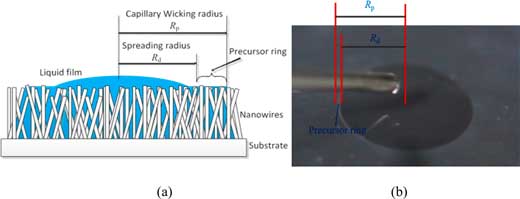| Posted: Jul 03, 2017 | |
Spreading and wicking of water droplets on nanostructured surfaces(Nanowerk News) Researchers in China performed an observation experiment with optical direct measurement was performed to investigate droplet spreading and capillary wicking on nanostructured surfaces fabricated by the hydrothermal synthesis method with various nanowire array types and nanowire sizes. |
|
| The liquid transport after a droplet touches a nanostructured surface can be divided into two parts: the spreading over the nanowires and the wicking in the nanowire layer. | |
| In their paper in Langmuir ("Water Droplet Spreading and Wicking on Nanostructured Surfaces"), the authors describe and analyzed quantitatively the behaviors of droplet spreading and capillary wicking on nanostructured surface with different array types and nanowire sizes using a visualization measurement. | |
 |
|
| Schematic of the droplets spreading and wicking on the nanostructured surface. (© American Chemical Society) (click on image to enlarge) | |
| In the figure above, the left image shows a schematic of the droplets spreading and wicking on the nanostructured surface. The droplets spread over the nanowires as the liquid imbibed into the nanowire layer and wicked into the channels formed by interlaced nanowires. | |
| The image on the right shows an image captured by the auxiliary camera. Rd is the droplet spreading radius (from center to contact line) and Rp refers to the capillary wicking radius (from center to wicking rim). A “precursor ring” formed between the three-phase contact line and the wicking rim. Rd and Rp were measured using an in-house MATLAB-based processing program that reduced the random disturbances and identified the droplet spreading and wicking rim boundaries. | |
| They found that the nanostructured surface with irregular nanowires gave faster spreading and wicking rates than the surfaces with regular nanowires due to the irregular nanochannel size distribution that promoted the spreading and wicking. | |
| The nanostructured surface with the medium height nanowires had the largest average spreading and wicking velocities of the three nanowire lengths studied in this work. |
 By
Michael
Berger
– Michael is author of three books by the Royal Society of Chemistry:
Nano-Society: Pushing the Boundaries of Technology,
Nanotechnology: The Future is Tiny, and
Nanoengineering: The Skills and Tools Making Technology Invisible
Copyright ©
Nanowerk LLC
By
Michael
Berger
– Michael is author of three books by the Royal Society of Chemistry:
Nano-Society: Pushing the Boundaries of Technology,
Nanotechnology: The Future is Tiny, and
Nanoengineering: The Skills and Tools Making Technology Invisible
Copyright ©
Nanowerk LLC
|
|
|
Subscribe to a free copy of one of our daily Nanowerk Newsletter Email Digests with a compilation of all of the day's news. |
